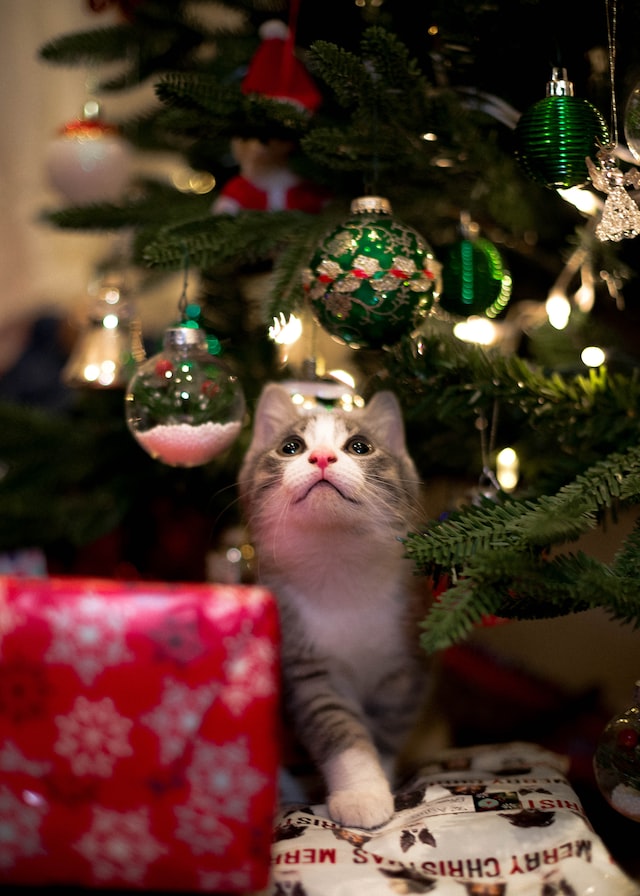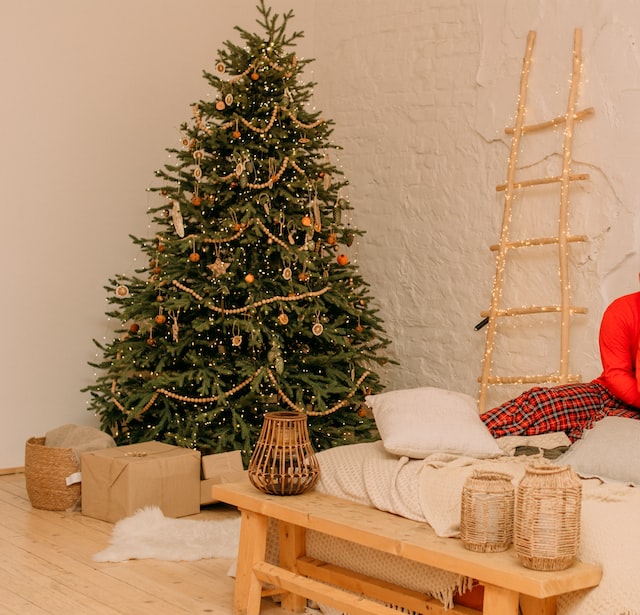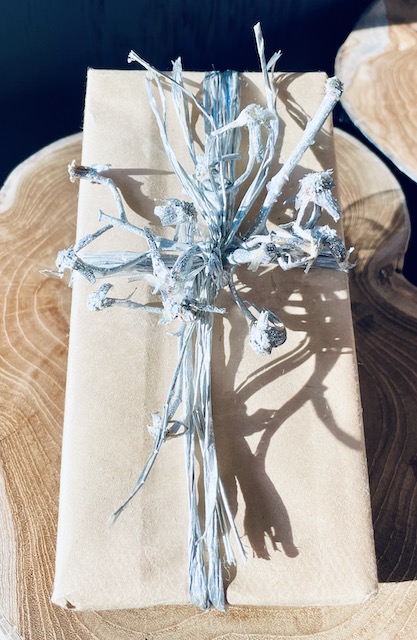
If you showed up at someone’s door in July with nine feet of evergreen, they wouldn’t let you in.
Come December, you’re a hero! A giant plume of fir or pine that eats up half the living room is the honoured guest of winter. It may represent a clear and present danger for fire plus there’s a good chance that the cat or a grandchild may topple that bejewelled tree, but none of that matters. Real or fake, this indoor tree is essential.
Real or fake, this indoor tree is essential.

How did this happen? What madness befell us that we decided that bringing the forest into our homes was the focus of the season?
Well, witchcraft plays a role. According to the historians, long ago people believed that hanging evergreen boughs in their homes would ward off evil spirits. The big deal here is that the foilage had to be evergreen. As days became shorter and foliage fell, the evergreen represented hope in the dead of winter; that the sun god would return. Celts and Vikings thought evergreens symbolized ever-lasting life. Today, we recognize that a dying fir tree in the house symbolizes ever-lasting vacuuming. Well, at least until Valentine’s Day.
One cold, clear night back in the 16th century Germany, Protestant theologian, Martin Luther, is inspired by the stars and has the idea of wiring candles onto his Christmas tree. Thus is born the Christmas tradition of cursing at strings of knotted lights. Henceforth, ornamented trees become associated with December 25th. Turns out, it was a regional thing. America, with its fundamentalist roots, didn’t take so kindly to blinged out Christmas trees.
Until late in the 19th century, Christmas decorations were considered a ‘pagan mockery’.
Until late in the 19th century, Christmas decorations were considered a ‘pagan mockery’. Massachusetts made it a penal offense to observe Christmas in any way other than attending a church service. There were fines for displaying decorations. Pennyslvia Germans were undeterred. Christmas trees were part of their tradition and they kept that alive in their new country. Nevertheless, right up into the 1840s, Christmas trees were regarded suspiciously as pagan symbols in the US.
The story of how Queen Victoria’s German husband introduced the Christmas tree to Britain is well known. In 1846, a sketch showing the royal family gathered around a decorated tree placed atop a table appeared in the Illustrated London News. Given Victoria’s popularity, this image was like an Instagram sensation. The girl had followers.
By the time the idea had gained a foothold in America, the notion of a table top tree had been supplanted by the idea of a tree that reached the ceiling.
Today, there are 1,364 Christmas tree farms in Canada, with Ontario having the most and BC taking second place. According to the 2121 Census of Agriculture, there are 50,803 acres of land under cultivation with trees destined for a living room. Canada harvests 2.4 million Christmas trees each year with the bulk of them going to Massachusetts – apparently well recovered from their restrictive covenants on heathen display – New York, New Jersey and Michigan. California, however, gets almost all of its trees from Oregeon.
Canada harvests 2.4 million Christmas trees each year ….
Christmas tree costs are up by about 15% this year from last year. The same factors that are affecting the price of lettuce and soap are affecting tree farmers. Depending on the species of tree, you’ll part with between $10 to $20 a foot. Still, it’s a lucrative business, generating $163.5 million in cash receipts in 2021.
Greenpeace says, in order to contain its carbon footprint, you have to use your artificial tree for 20 years. If you’re expecting heated debate on the topic of Fake-mas trees versus farmed trees, ward off your personal evil spirits with some evergreen boughs over the table. Earbuds help, too.
Register for The Plain Jane newsletter and stay up to date with upcoming contests.
This week’s question for readers:
FAKE OR REAL? HOW DO YOU ROLL ON THE TREE ISSUE?
Leave your Comments below!
Submissions to last week’s question:
How does your family handle this seasonal chore. Are you making earth-friendly changes?
SUBMISSIONS:
Read your column every week and enjoy it thoroughly! Re the wrapping on your gift this week, I thought perhaps it was hemp at first, but upon closer examination, my official guess is that you used the stalks from your tomato plants.
Gary Houghton
We at the Marquis household, have made a new policy- that wrapping of gifts may only occur only in regular household containers. So, over the years, our wrappings have ranged from the weird (a vacuum part) to the wonderful (tablecloths and napkins). Other interesting choices have been pillow cases, clean paint can, random wood pieces, old cereal boxes and other such available sundry. It has definitely made the traditional gift wrapping very humorous, as we all compete to wrap our gifts in the most non-conventional way. Best of all, we have reduced our waste to negligible, which was always our intention. We challenge your readers to join us, in the strangest christmas wrap contest! It’s easy to start- your own newspaper, reused once again, with paint stamps or drawings!
Joanne and John Marquis
Our son surprised us with an appeal in our Messenger family chat: “This Christmas please consider using recyclable paper like newspaper to wrap presents. Not elegant, but we are saving the planet and money as well.” His wife followed up his message: “We have lots of used wrapping paper in our attic free for everyone!” Sounded like what we did the other year: carefully unwrapping our birthday presents so that the wrappers could be used for everyone’s presents on their birthday. For all eight family members, we succeeded in using the same wrappers from the first birthday on March 16 to the last on December 1!
John Marasigan
In my family we have zero garbage at Christmastime. Some years ago I bought several different lengths of Christmas fabrics. I made these up into about 20 different sized bags for each member of the family and identified each person’s with a different coloured drawstring cord. The sight under the tree is a wonderful display of colours and after the presents are all opened the bags get returned to the correct owner ready for next year.
Ann Ligertwood
he visual of 45,000 hockey rinks covered with Christmas wrap is disturbing to me. Ideally, only recyclable wrapping paper should be available to consumers. . For many years, I have only used reusable cloth drawstring gift bags of various sizes. Most of these cloth bags were freebies from gas fill-ups, saved many years ago, or purchased cheaply from local thrift stores. I am proud of my family for adopting this earth-friendly habit of not contributing to the seasonal problem of discarded gift wrap.
Paula Alvaro
Gift wrapping in our family when I was a child involved lots of recycled gift wrapping paper. My mother’s side of the family celebrated Christmas on Christmas Eve with a delicious turkey dinner and lots of presents beautifully wrapped. When we said “good night” we took all our presents and the used wrapping paper home with us. On Christmas Day we celebrated with my father’s side of the family and wrapped their presents in the used paper from the night before. My father’s sister, my aunt, would take the used wrapping paper home with her to wrap presents for my uncle’s side of the family to celebrate on Boxing Day! It was always fun the next year to “recognize” paper from the previous Christmas. Today our family uses cloth gift bags – gifts from Esso gas stations many years ago and ones made by me from beautiful Christmas fabric. They too are recycled many times!
Leslie Purvis
For years our extended family has used cloth bags. I made many sizes in a large variety of wonderful Christmas fabrics that look beautiful and as varied as paper wrapped. We also reuse fabric tags so everyone knows when opening a gift, they read the tag, and pass it to me for safekeeping before opening the bag. This process means one can easily wrap and label a gift in under a minute. They look fantastic, in the long run we save money and, when Christmas, is over our recycle bin is still practically empty!
Cassandra McLure
I am an avid reuser and recycler so I haven’t bought Christmas cards or wrapping paper for several years. I make cards from the ones I’ve received in past years. Noone would recognize them since I cut and rearrange the images. I’ve saved all the wrapping paper from gifts that I’ve been given, never tossing the paper into the garbage or recycling bins. The most beautiful papers are turned into collage on boxes that I use to store Christmas decorations. This year my nine year old granddaughter found my containers of paper and ribbons and used them to make outfits for her stuffed animals and dolls.
Joan Ellis
My mother was the original recycler, using newspaper and paper bags to wrap gifts with raffia and cloth ribbons, and cutting up Christmas cards for gift tags. All of which was horribly embarrassing for a teenager in the 70s. Homemade cloth gift bags appeared with the grandchildren and are still used to this day. When my kids were young, I invested in some good quality gift bags, a novelty then; still lovingly preserved and utilized and a source of amusement for teenagers who now have kids of their own and employ all of the above. And let’s not forget about decorating gifts with garden bounty like your silver ‘bow’!
Lonna Ogston

